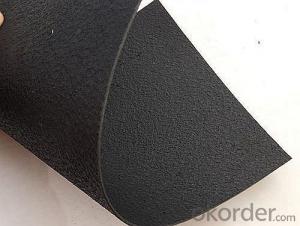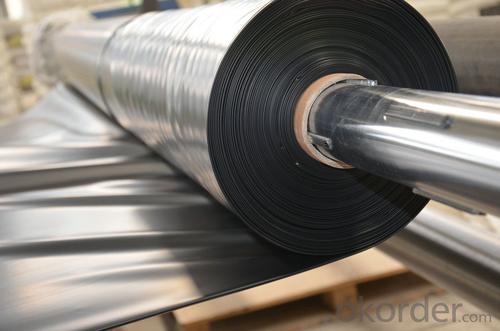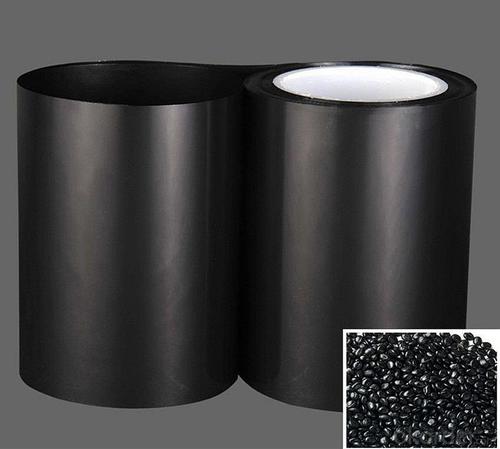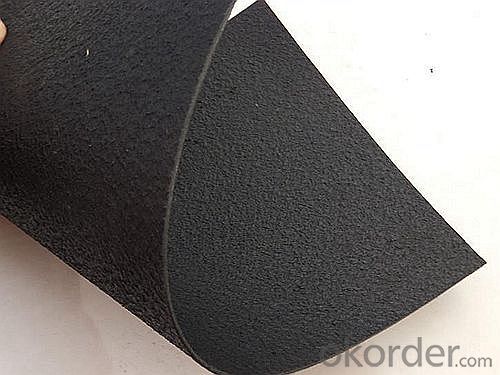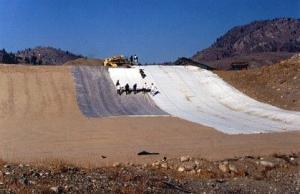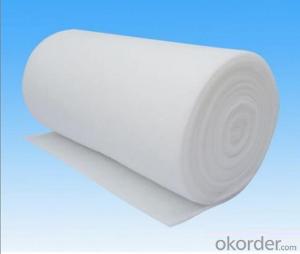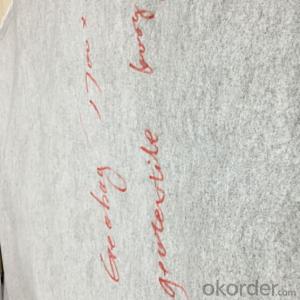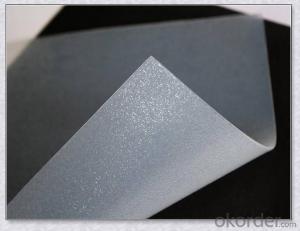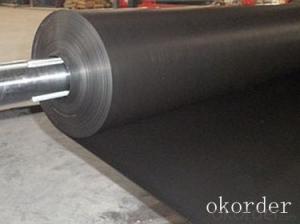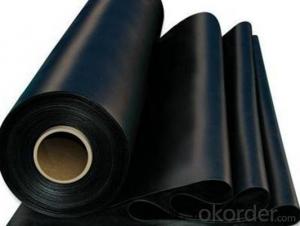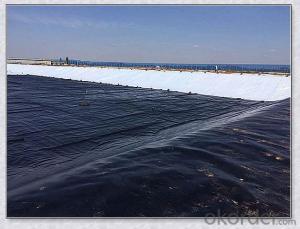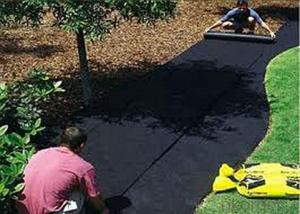Polypropylene Geotextile Reinforced HDPE Geomembrane for Decorative and Architectural Ponds
- Loading Port:
- China main port
- Payment Terms:
- TT OR LC
- Min Order Qty:
- 1000 m²
- Supply Capability:
- 1000000 m²/month
OKorder Service Pledge
OKorder Financial Service
You Might Also Like
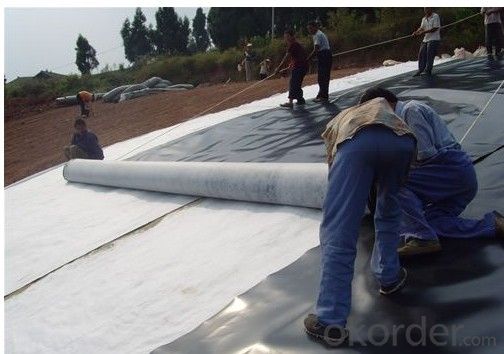
HDPE Geomembrane
Thickness: 1.0mm to 3.0mm
Roll Size: 4m-9m in width
roll length as design or client’s request
LDPE Geomembrane
Thickness: 0.1mm to 3.0mm
Roll Size: 4m-9m in width
roll length as design or client’s request
LLDPE Geomembrane
Thickness: 0.5mm to 3.0mm
Roll Size: 4m-9m in width
roll length as design or client’s request
Technical specifications of HDPE geomembrane:
a) Density ≥ 0.94g/m2
b) Tensile Strength ≥25Mpa
c) Elongation at Break ≥ 550%
d) Right-angled Tear ≥ 110N/mm
e.)Puncture Strength ≥ 550N
f.) Permeability Coefficient ≤1.0xe-13gNaN/(cm2.S.Pa)
g.) -70oC Low Temperature Impact Brittle Property: good.
h.) Chemical Resistance: at 80oC, marinated in 5g/L Nacl for a long time, it will not erode or swell.
Our Service
1.On a regular basis or as per your request,we entrust national testing agencies to conduct quality inspections
2. Strictly in accordance with the ISO9001-2008 international quality system standard,we monitor and manage the whole process throughout production,quality testing,and measurement to ensure product quality
3. For quality-related construction delay or substandard construction(except for damage or losses due to customer’s responsibility or irresistible natural disasters),we have refunding,replacement,and repair services.We will respond to customers’ feedbacks on quality issues within 24 hours.
4.When the construction is completed,as your request,our technical staff may participate in the final acceptance.
FAQ:
Q: What kind of payments does jenor support?
A: T/T, L/C, Cash are accepted.
Q: Do you charge for the samples?
A: Accordeing to our company policy, the samples are free, we only charge the freight fee. And we will return the freight fee during the next order.
Q: Can you produce according to customers' design?
A: Sure, we are professional manufacturer, OEM and ODM are both welcome.
Q: Do you have other products?
A: Yes, please check the pictures:
- Q: Can geotextiles be used in mining tailings management?
- Yes, geotextiles can be used in mining tailings management. Geotextiles are commonly employed as part of a containment system to prevent the spread of contaminated tailings and to provide stability to the tailings impoundment. These textile materials can help separate and filter the solids from the liquid in tailings, reducing the risk of water pollution and improving the overall management of mining waste.
- Q: Do you have a drainage board and geotextile on the roof
- Good, but you use very little, the purchase is difficult, the price will not be cheap Huazhi geotextile material manufacturers
- Q: Woven geotextile customs code is how much
- To see what material system, even if there are many kinds of chemical fiber, such as long fiber staple fiber, polyester nylon and what process after dyeing, yarn dyed, printing and other processes are impregnated coating, etc. you reported a name not check of
- Q: What are the specifications of the garage roof using geotextiles?
- Generally with 200g or 300g, I professional production, wish smooth
- Q: Geotextile with ordinary non-woven like not? The
- Geotextile is divided into acupuncture cloth and woven fabrics, and some places geotextile also known as non-woven fabrics
- Q: How do geotextiles help with soil separation?
- Geotextiles help with soil separation by providing a barrier between different soil layers or materials. They prevent the mixing and migration of soils, allowing for better drainage and filtration. Geotextiles also help to distribute loads more evenly, reducing the likelihood of soil erosion and maintaining the stability of the soil.
- Q: What kind of geotextile is used to repair the road?
- Geotextile in the application of the road: a slope care, specifications in the 250-350g / m2 its role has the following three points: 1. filter when the water from the fine soil into the coarse soil layer, the use of polyester staple fiber Acupuncture geotextile good permeability and water permeability, so that water through, and effectively carrying soil particles, sand, small stone, etc., in order to maintain the stability of soil and water engineering. 2. Drain polyester staple fiber geotextile has a good water conductivity, it can form a drainage channel within the soil, the soil structure of excess liquid and gas efflux. 3. Protection of water flow on the soil erosion, the effective concentration of concentrated diffusion, transmission or decomposition, to prevent the soil by external forces and damage. Second, the foundation treatment, the main role is to strengthen. The use of polyester staple acupuncture geotextile to enhance the soil tensile strength and resistance to deformation, enhance the stability of the building structure to improve soil quality. Specifications not low 400g / m2. The main role is to use the polyester staple fiber geotextile with different physical properties (particle size, distribution, consistency and density, etc.) of the building materials (such as soil and sand, soil and concrete, etc.) ) To isolate. So that two or more materials are not lost, not mixed, to maintain the overall structure and function of the material, so that the building capacity to enhance the capacity. Specifications in the 150-400g / m2
- Q: Are geotextiles suitable for use in landfill applications?
- Yes, geotextiles are suitable for use in landfill applications. Geotextiles can effectively control erosion, provide drainage, and enhance soil stability in landfills. They also help in preventing the migration of fine particles and provide separation between different layers of waste materials, ensuring proper functioning and longevity of the landfill.
- Q: Can geotextiles be used in temporary erosion control applications?
- Yes, geotextiles can be used in temporary erosion control applications. They are often used to stabilize soil and prevent erosion by providing a barrier between the soil and water or wind. Geotextiles can be used in various temporary erosion control measures such as slope stabilization, sediment control, and construction site erosion control.
- Q: How do geotextiles aid in the reduction of seepage flow?
- Geotextiles aid in the reduction of seepage flow by acting as a barrier that prevents the movement of water through soil. They are designed to allow water to pass through while retaining fine particles, effectively reducing the flow of water and preventing soil erosion.
Send your message to us
Polypropylene Geotextile Reinforced HDPE Geomembrane for Decorative and Architectural Ponds
- Loading Port:
- China main port
- Payment Terms:
- TT OR LC
- Min Order Qty:
- 1000 m²
- Supply Capability:
- 1000000 m²/month
OKorder Service Pledge
OKorder Financial Service
Similar products
Hot products
Hot Searches
Related keywords



